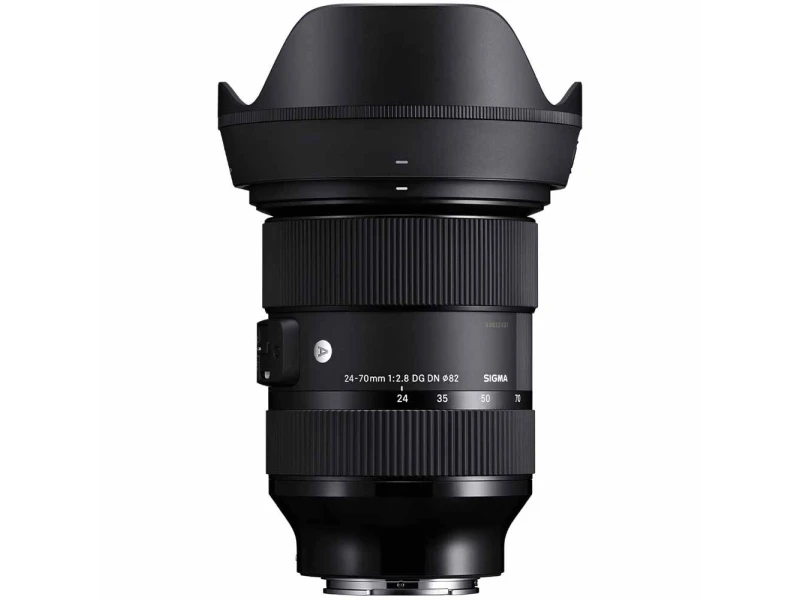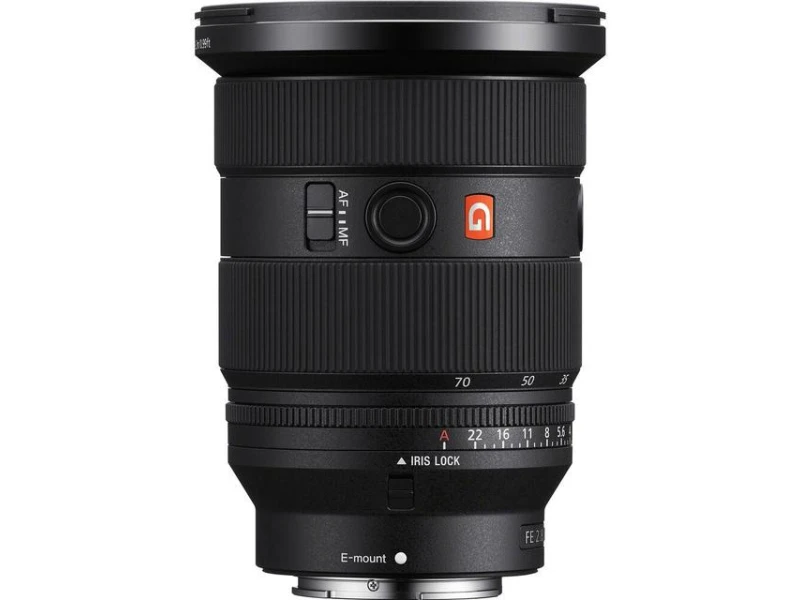Sigma 24-70/2.8 DG DN Art (Sony E) vs Sony FE 24-70mm f/2.8 GM II
Sigma 24-70/2.8 DG DN Art (Sony E) vs Sony FE 24-70mm f/2.8 GM II
When comparing Sony FE 24-70mm f/2.8 GM II and Sigma 24-70/2.8 DG DN Art (Sony E), which one is better?
1. Lens Weight Comparison
Regarding the weight of the lenses, Sony FE 24-70mm f/2.8 GM II is the winner with a weight of 695 g compared to the 830 g that Sigma 24-70/2.8 DG DN Art (Sony E) weighs.
Winner: Sony FE 24-70mm f/2.8 GM II
Regarding weight: The weight of a lens is something you need to consider, since you have to carry it around on the camera as long as you're shooting. It adds to the total weight of your camera and it's important to keep the weight low if you get tired in your arms when taking photographs or filming.
2. Lens Mount Comparison
These two lenses use the same lens mount, the Sony E. This means that both lenses are compatible with cameras that use this mount.
Winner: Tied
Regarding lens mount: Popular lens mounts are Canon RF and EF, Micro Four Thirds and Nikon Z. Different lens mounts lets you connect different lenses to camera bodies, but some might not be compatible. This can be helped by using an adapter, like a Canon EF to RF adapter.
3. Largest Aperture Comparison
Both lenses share the same aperture of 2.8 — this means that you may buy both Sigma 24-70/2.8 DG DN Art (Sony E) and Sony FE 24-70mm f/2.8 GM II in this regard; they''re the same.
Winner: Tied
Regarding largest aperture: A lower aperture number means that the widest aperture on the lens is larger. This means that more light will hit the sensor and also that the depth of field will be shallower, better separating your subject from the background.
4. Anamorphic Comparison
Neither Sony FE 24-70mm f/2.8 GM II or Sigma 24-70/2.8 DG DN Art (Sony E) are anamorphic lenses.
Winner: Tied — Neither have this feature
Regarding anamorphic: Anamorphic lenses are usually used on cinema cameras and squeezes the image when its recorded, which gives the final, stretched out, image oval bokeh and a different angle of view. The most common lenses, however, are not anamorphic but spherical, which gives a spherical bokeh and is a much cheaper lens design.
5. Focus Distance Comparison
Sigma 24-70/2.8 DG DN Art (Sony E) features a minimum focus distance of 18 cm while Sony FE 24-70mm f/2.8 GM II has a minimum focus distance of 21 cm. Depending on your shooting style, the Sigma 24-70/2.8 DG DN Art (Sony E) might be a better choice.
Winner: Sigma 24-70/2.8 DG DN Art (Sony E)
Regarding minimum focus distance: The minimum focus distance of a lens is the smallest distance from the lens to the subject you want to be in focus; subjects closer than the lens' minimum focus distance will not be in focus. Whether or not this is important to you is up for you to decide, but some want to take close photos and videos and in those cases it's important to have a lens with a low minimum focus distance.
6. Lens Type Comparison
Both lenses are Zoom lenses, which means that you can choose both Sigma 24-70/2.8 DG DN Art (Sony E) or Sony FE 24-70mm f/2.8 GM II if you're looking for that type of lens.
Winner: Tied
Regarding type: There are two types of lenses; zoom lenses and prime lenses. Prime lenses have a fixed focal length and cannot be zoomed, while zoom lenses have a focal length range and can be zoomed in to get closer to the subject. Prime lenses are usually lighter, cheaper and let in more light. Zoom lenses are more versatile but are more expensive since they require a more advanced lens design.
7. Filter Thread Comparison
Winner: Tied
Regarding filter thread diameter: The filter thread diameter is the size of which the lens is compatible with screw-on filters, such as CPL, ND or IR filters. If you have several lenses of a certain size, it might be a good idea to keep the same filter thread size to make sure your filters work on all your lenses. If not, then you may buy step up rings to adapt from a certain diameter to the filter thread diameter of your other lenses.
8. Aperture Blade Comparison
Both Sigma 24-70/2.8 DG DN Art (Sony E) and Sony FE 24-70mm f/2.8 GM II have 11 aperture blades, which means they should both have a similar bokeh shape and roundness.
Winner: Tied
Regarding aperture blades: The number of aperture blades makes a difference because the bokeh is smoother the more aperture blades the lens has. Of course, this does not mean the lens is better in other regards, but it can be an interesting aspect when deciding of a lens.
9. Stabilization Comparison
Neither Sigma 24-70/2.8 DG DN Art (Sony E) or Sony FE 24-70mm f/2.8 GM II feature built-in image stabilization.
Winner: Tied — Neither have this feature
Regarding image stabilization: When a lens features built-in stabilization, it will actively help you hold the image steady by adjusting the optical elements inside the lens to compensate for movements. Do remember that lens stabilization is not required, but it may be suitable depending on your specific needs.
10. Parfocal Comparison
Sigma 24-70/2.8 DG DN Art (Sony E) is parfocal, which might be important to you if you. Sony FE 24-70mm f/2.8 GM II is not parfocal.
Winner: Sigma 24-70/2.8 DG DN Art (Sony E)
Regarding parfocal: The term "parfocal" means that the lens will keep the focus point in focus while you zoom the lens. This feature is more common in cinema lenses and more expensive photography lenses, and is not featured in all zoom lenses. It is, however, not required if you're not shooting video and zooming while filming. If you are zooming and require the focus to be kept regardless, then a parfocal lens might be worth it for you.
11. Autofocus Comparison
Both lenses have autofocus, which means that they're both great at focusing targets while taking photographs or filming video. Just remember, most cameras do not offer good autofocus while filming video.
Winner: Tied — both have this feature
Regarding autofocus: Lenses with autofocus help you focus when shooting pictures or video. If a lens only has manual focus it means that you have to focus manually by adjusting the focus wheel on the lens. Most cinema lenses do not use autofocus and are manual focus only.
12. Macro Comparison
Neither Sigma 24-70/2.8 DG DN Art (Sony E) or Sony FE 24-70mm f/2.8 GM II are macro lenses.
Winner: Tied — Neither have this feature
Regarding macro: Macro lenses can focus much closer to your subjects and might be suitable when photographing flowers, insects, wildlife and nature.
Specifications
Full specifications table of Sigma 24-70/2.8 DG DN Art (Sony E) and Sony FE 24-70mm f/2.8 GM II:
| Sigma 24-70/2.8 DG DN Art (Sony E) | Sony FE 24-70mm f/2.8 GM II | |
 |  | |
| Brand | Sigma | Sony |
| Weight | 830 g | 695 g |
| Lens Mount | Sony E | Sony E |
| Focal Length | 24 - 70 mm | 24 - 70 mm |
| Largest Aperture | 2.8 | 2.8 |
| Anamorphic | No | No |
| Minimum Focus Distance | 18 cm | 21 cm |
| Type | Zoom | Zoom |
| Aperture Range | Missing | 2.8 - 22 |
| Filter Thread Diameter | 82 | 82 |
| Aperture Blades | 11 | 11 |
| Lens Groups | 15 | 15 |
| Lens Elements | 19 | 20 |
| Image Stabilization | No | No |
| Parfocal | Yes | No |
| Autofocus | Yes | Yes |
| Macro | No | No |
| Weather Seal | Missing | Yes |
| Full Frame Coverage | Missing | Yes |
| Lens Hood Included | Missing | Yes |
